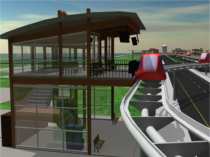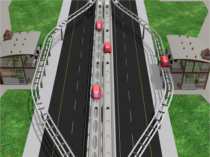District
SERVICE PLAN
(PDF Format)
Metro
District as a Tool for an Economic Generator
Airpark Village proposes a Metro District to provide the services and the governance for all properties within its boundaries. Expected services comprise water, sewer, storm drainage, refrigerated water, grey water recycling, telecommunications, tele-library, SmartSkyways, gas, alternative power, trash, incineration, security, landscaping and roads. Some of these services will generate revenue and others will attract a tenant base. The innovative infrastructure will be a prototype that can be marketed to resorts, malls, campuses, airports, office parks, cities and state agencies. Airpark Village will attract companies desiring to promote alternative energy and transit systems and will use the mock up area for future infrastructure installations.
The Metro District improvements will be funded by a $25 Million start up program for constructing a next generation of infrastructure to attract a national market to the site. This start up will be privately funded by investors through a Metro district that spreads the cost of improvements over 5,000,000 sf of net saleable land divided into 19 tracts. Each square foot of land will then have a $4 to $5 per sf infrastructure lien. Purchasers of each tract will pay interest to the investors for only 7 years at which time the Metro District debt will be refinanced.
How will the proposed Metro District be funded?
- The initial funding will be private funds invested in Skyways, the infrastructure builder, who then buys all the bonds issued by the Metro district.
- Investors earn 6% interest on the District bonds.
- Investors get 50% of the commercialization profits from future sales.
- The exit strategy for the private investors is to refinance the Metro district when 2/3 of the land is sold, or in about 7 years. The publicly offered refinancing bond issue will include amortization over approximately 25 years.
- The revenue stream for the refinancing issue will be from an increase in the mill levy, district-wide fees or a combination.
The initial funding of $20 to $25 million will pay for the installation of infrastructure, the adaptive reuse of the existing hangars, and the renovation of the terminal which comprises about 53,000 sf. Most of these buildings need remodeling to occupy, but they exist and can be modified for use as temporary facilities.
What are the City’s role, liability, and risk in this Metro District?
The Metro District exists separately from the City. It is a quasi-municipal corporation operating with an elected five-person Board of Directors. The City Council must approve the Service Plan for the District. Then the Service Plan is filed with the Court and an election is ordered. Those who vote in the election are Colorado registered voters who: a) live within the District; b) own taxable property within the District, or c) are the spouse of a property owner in the District. The State statutes governing metro districts ensure that the City assumes no liability for the District and is not obligated in any way to pay any debt incurred by the District. The private funding component also relieves the City from any ethical responsibility it might feel for the payment of debt service as it could if the bonds were publicly issued. In addition, the initial debt structure will be crafted in a manner that safeguards the investors from any possibility of default.
Why does Airpark Village need to use the tool of a Metro District rather than the tool of an SID (and what's the difference)? (See legal comparison - PDF Format, 173K)
A Metro District offers the landowners:
1. Control of the construction, operation and maintenance of the infrastructure that includes experimental products to be built in the first stages.
2. The ability to issue debt.
3. The power to impose property taxes and other fees and charges.
4.
Responsibility
in perpetuity for the continued improvement, operation and maintenance of
the
infrastructure within the District.
5. The ability to exercise eminent domain powers, if necessary.
6.
The
means to construct and operate utilities that may not be subsequently dedicated
to the
City.
A special improvement district is:
- Under the control of the City of Fort Collins and governed by the City Council.
- Able to issue debt under
the name of the City. Although this is not a general
obligation debt
of the City, a default would likely have a negative impact on the City’s overall bond rating. - Formed with or without the consent of the property owners.
- Created to construct public infrastructure that is then maintained by the City.
- Limited to a revenue stream based on special
assessments. The assessment levied
on any
property within the district cannot exceed the special benefit to the property that is the result
of the improvements constructed. - In a secondary lien position to general property
taxes. Perfection of the lien might
require
payment of delinquent property taxes.
What improvements will the proposed Metro District fund?
Martin/Martin, a large well-known
engineering company whose projects include DIA, Coors Field
and Meridian,
estimated the costs for the proposed Airpark Village infrastructure. It is
presented
in detail in the attached appendix.
Utilities:
· $ 4 Million for roadways, sidewalks, signalization, and landscaping
· $ 2 Million for utility mains
· $ 1 Million to lower water table
Economic Generator Investments:
· $13 Million for Skyways
· $ 5 Million in Labs with CSU (optional)
Why is the investment in “Economic Generators” important?
Economic generators are essential to the fiscal health and prosperity of any community. An economic generator contributes into the economy by way of its demand- and supply-side effects. For example, Colorado State University’s payroll and operating expenses spent locally, and local purchases made by students and persons attending university-related functions. The economic generator also creates jobs and produces income for businesses that support its base activities.
The job creator for Airport Village is estimated at 15,000 jobs in 15 years because:
* The Skyways
and Labs attract users
* Users need
employees to set up and to grow
* This spins
off into local businesses that support the users of Airpark Village
Why is a research campus such a viable development concept?
Timeliness. Within the 2 to 3 years it takes to build the infrastructure, Airpark Village will draw national attention just when the need for alternative energies, transport, robotics and automation will explode because of increasing gas prices and concerns about the erosion of the environment from the increased consumption of fossil fuels. This infrastructure will attract a national market of companies getting into or expanding their R&D into any of these fields.
Integrated research facilities. Construction of the skyways gives Airpark Village a unique demonstrative model for transportation as well as a test bed for alternative energies. Linkage with test labs for small engines using non-fossil fuels, alternative energies like solar cells, and on-site water treatment will create the right medium for experimentation and development of technologies that transfer to commercial success.
What can this mean for the City of Fort Collins?
Innovation. The City has adopted a goal of increasing innovation. Airpark Village is a huge public private partnership to build an “Innovative” economic generator that creates R&D jobs. Our plan is to use next generation infrastructure to attract out-of-state companies that have R&D projects to open branch offices on our property.
Economic & Environmental Leadership. Our research theme is “Beyond Oil”. The global oil economy is sliding into end times as fewer supplies are found each year and yet the demand is outrunning supply. Industry forecasters are saying gas will rises to more than $5 per gallon permanently within 5 to 10 years. $100s of billions will be invested in a research feeding frenzy worldwide. Airpark Village will seek a 1% portion of it with our research campus. Over 15 to 25 years, this demand for R&D will grow a campus with about 4000 or so primary research jobs on site plus supporting service jobs of another 2500 to occupy 3 million sf of mixed commercial uses, plus 1500 residential units. Airpark Village will have a ripple effect of 10,000 supporting jobs in the local community for all the professional services, warehousing, maintenance, food, banking, suppliers, information technology and many other services.
Little Risk. All the money that is required is from private investors. The City’s role will be to provide the policies that attract business and to approve the necessary district framework such as a Metro District, Urban Renewal District, and an experimentation district allowing for R&D infrastructure to be constructed, operated and maintained without dependence on the City.
What will happen first?
Five existing buildings will be reused as temporary facilities:
* The main hangar shown below will be converted into a lab and the
demonstration area for the R& D technologies.
* The terminal will become the software development lab for automation, a
control room and operations office.
* Three larger hangars will be temp research labs for energy, engines,
water and robotics.

Initial Development Area
* CSU will build an electric power-generating engine that
runs on alternative fuels for our first lab. This will provide power for
the Skyways, streetlights and all initial buildings.
* A conference/hotel complex, various labs in temporary buildings and a
future consolidated building will follow.
* When the hotel is built, a heliport will replace the temporary labs to
provide conference attendees a connection with DIA.
* A parking garage and bus/van terminal that connects to the Skyways
station will be constructed below the helipad.
Backbone Infrastructure in a Single Corridor

This six lane street section is the typical condition in most of the urban environments where Skyways will be marketed and thus is the most appropriate model.
A One Mile Demonstration Model
Initial funding will also build a one mile Urban
Transport Corridor (below) that advances the “State of the Art” in
automated guideway transportation. It will attract companies in the
business of researching and developing all components of fixed guideway
transportation systems. Companies will use this infrastructure to
experiment with next generation propulsion engines, alternative energy,
automation, robotics, water treatment and recycling, security and wideband
Telecom.
The pictures below show the initial infrastructure development that we
plan to use to attract R&D for the components. The commercialization
of these infrastructures is expected to address the issues of “Beyond
Oil”. As America slides into the end times of the oil based economy, we
will have the affordable next generation of infrastructure to show an
international audience.





|
|
|||||||||||||||||||||||||||||||||||||||||||||||||||||||||||||||||||||||||||||||||||||||||||||||||||||||||||||||||||||||||||||||||||||||||||||||||||||||||||||||||||||||||||||||||||||||||||||||||||||||||||||||||||||||||||||||||||||||||||||||||||||||||||||||||||||||||||||||||||||||||||||||||||||||||||||||||||||||||||||||||||||||||||||||||||||||||||||||||||||||||||||||||||||||||||||||||||||||||||||||||||||||||||||||||||||||||||||||
Location | Site | Neighborhood | City | Research Campus | Planning | News | Oil
Offered
by Lloyd Goff
Phone: (303) 671-5340
Email: [email protected]
Please visit our automated guideway transport site at www.smartskyways.com
